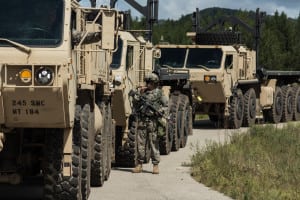The Army has selected Oshkosh Defense [OSK], Mack Defense
, Navistar Defense and a team of American Rheinmetall Vehicles and GM Defense [GM] to deliver prototypes for its next-generation tactical truck program, with plans to begin evaluating vehicles in early 2024.
Following the prototype process, the Army said it plans to approve final requirements by fiscal year 2026 and then hold a full and open competition for the likely multi-billion production contract to build its future Common Tactical Truck (CTT) fleet.

“The CTT program seeks to mitigate current gaps in driver safety systems, autonomy, fuel consumption, and predictive maintenance,” the Army’s Program Executive Office Combat Support & Combat Service Support (PEO CS&CSS), wrote in a statement. “The CTT program is intended to redesign the fleet to integrate commercial technologies such as advanced driver assist systems, autonomy ready (foundation for future autonomy), fuel efficiency, exportable power, as well as prognostics and predictive maintenance.”
The four vendors selected for the effort were awarded $24.3 million in deals and are tasked with delivering three prototypes for each CTT variant, as well as providing digital designs and conducting a design study for a potential wrecker platform.
AM General, which announced in October that it had teamed with Iveco Defense Vehicles (IDV) to offer a CTT proposal based on IDV’s line of High Mobility Range Vehicle trucks, did not receive a contract to work on the prototype effort.
CTT is intended to replace the Army’s current Family of Heavy Tactical Vehicles (FHTV) truck fleet, currently built by Oshkosh Defense, with new variants that utilize a common chassis and meet roles for the M915 Line Haul Tractor and M1088 Medium Tractor; Palletized Load System (PLS); and Heavy Expanded Mobility Tactical Truck (HEMTT).
“The FHTV’s flexible architecture allows it to support a multitude of missions with the ability to scale up or down with minimal change to the vehicle,” Oshkosh Defense said in a statement on Monday. “For decades, Oshkosh Defense has partnered with the U.S. Military to develop, test, and evolve advanced military and commercial technologies and integrate them onto the FHTV. The Oshkosh Defense CTT variants offer these technologies to achieve the U.S. Army’s desired capabilities of active safety, fuel demand reduction, autonomy, mission flexibility, prognostics, commonality, and superior survivability.”
Pat Williams, Oshkosh Defense’s chief programs officer, told Defense Daily in October the CTT program is “right in our wheelhouse,” citing the experience the company will leverage from its work on the FHTV program and new capabilities it has developed (Defense Daily, Oct. 10).
“The purpose of the program is to upgrade the heavy and the linehaul logistics fleet, which is what we do. That’s exactly what we do for the Army right now,” Williams said in an interview at the Association of the United States Army’s annual conference in Washington, D.C. “[Oshkosh Defense] has developed a lot of the capabilities that the Army is seeking. I think we just need to put those together. Because we have a great fleet. We have solutions that are already developed to incorporate into the fleet to meet the CTT requirements. So we look forward to incorporating those things together and getting those trucks in testing.”
American Rheinmetall Vehicles previously announced in August it had teamed with GM Defense for CTT and would offer an ‘Americanized’ version of Rheinmetall’s new HX3 truck, which the German defense firm first unveiled in 2021 (Defense Daily, Aug. 17 2022).
“We are committed partners to the Army, bringing tremendous operational capability coupled with advanced safety features, ensuring our soldiers can achieve their mission safely and effectively. Together our team will deliver a transformational truck that leverages the commercial strengths of our partners, Rheinmetall MAN Military Vehicles and General Motors, and the commonality of the HX3-CTT design,” Matthew Warnick, American Rheinmetall Vehicles’ managing director, said in a statement on Monday.
A GM Defense spokesperson previously told Defense Daily the company’s contribution to the partnership will include leveraging its experience with rapid prototyping, agile design and engineering and rapid delivery.
“Winning the CTT prototype phase demonstrates the undeniable value that the strategic collaboration between GM Defense and American Rheinmetall Vehicles brings to this important, next-generation Army program,” Steve duMont, president of GM Defense, said in a statement following the prototype award announcement. “We are excited to bring our advanced technologies and manufacturing prowess into this important collaboration and deliver a proven, modern solution to enhance warfighter capability. We look forward to continuing our work with American Rheinmetall Vehicles to execute the first prototype phase, while gaining the necessary insights to strengthen our position to win future phases of the program.”
American Rheinmetall Vehicles and GM Defense in their statement said the CTT program, when in production, could be worth up to $14 billion and total around 40,000 trucks.
Mack Defense, which currently produces the Army’s new M917A3 Heavy Dump Trucks, noted its working with Robotic Research on the autonomy capability for CTT and has cited the benefits it can leverage from parent-company the Volvo Group, adding its “the second largest commercial vehicle manufacturer in the world.”
“What we’re touting is the fact that we come from one of the largest commercial vehicle manufacturers. We have that global capability, we have that global maintainability supporting infrastructure,” David Hartzell, president and CEO of Mack Defense, said in an October statement after the company announced it had submitted a CTT bid. “We’re leveraging all of that capability. The government’s not going to pay us to develop an active safety system, or they’re not going to pay us to develop an autonomous capability. We’re bringing that technology development with us — in many cases, we’re the forerunners in that capability, in that type of technology.”